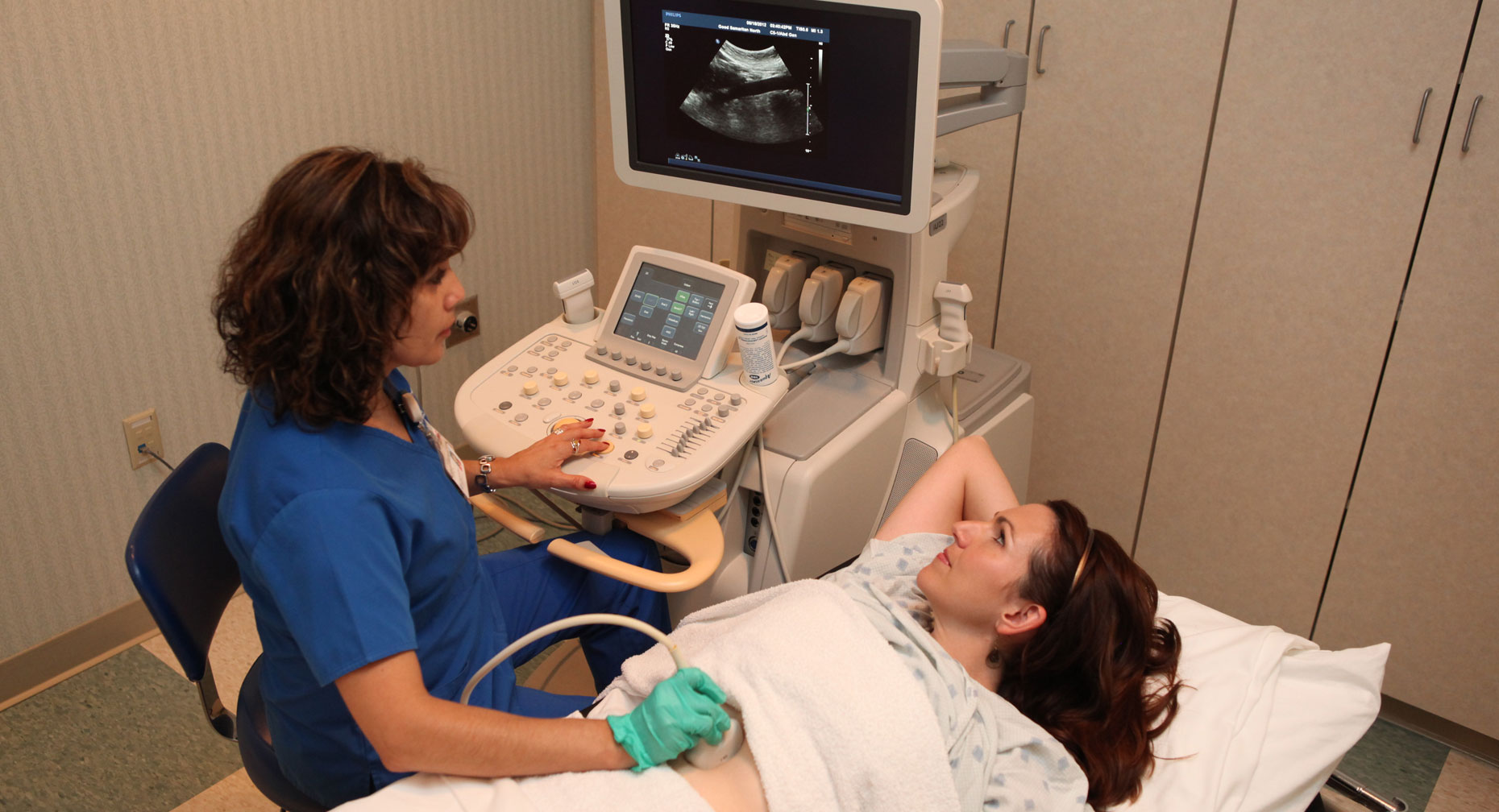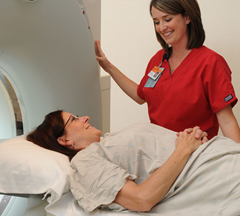Cancer
When cells in your body grow out of control, cancer results. And it can spread to other parts of your body. Premier Health providers offer advice on how to lower your risk of developing cancer, how to recognize cancer signs, and how cancer is diagnosed
to help catch it early and raise the chance of successful treatment.
7 Steps To Diagnosing Uterine Cancer

Find Your Perfect Match
Answer a few questions and we'll provide you with a list of primary care providers that best fit your needs.
If you have uterine cancer, an early diagnosis greatly improves your chances of being restored to good health.
There is no routine test to screen you for uterine cancer. So give yourself – and care team – the best chance of beating this cancer by seeing your doctor quickly about any abnormal vaginal bleeding or pelvic pain.
Many of the symptoms of uterine cancer can also be caused by less serious conditions.
“Many of the symptoms of uterine cancer can also be caused by less serious
conditions,” says gynecologic oncologist Michael S. Guy. “With more than 60,000 women diagnosed each year with uterine cancer, we want to find answers as quickly as possible to the source of the symptoms and then offer treatment.”
The most common type of uterine cancer is endometrial cancer, which starts in the endometrium, the lining of the uterus. Uterine sarcoma is less common and begins in the middle layer of the uterus, the muscular myometrium.
Dr. Guy talks about the symptoms and risk factors of uterine cancer.
Click play to watch the video or read video transcript.
The most common symptom of uterine cancer is going to be abnormal bleeding after menopause. The most common type of uterine cancer that we treat is endometrial cancer. Again, those patients tend to have gone through menopause, have not bled for some time and have new onset bleeding.
A Proven Path To Detect Uterine Cancer
 If your risk is high or if you notice some of the
signs of uterine cancer, your doctor may recommend several of these steps to make an accurate diagnosis:
If your risk is high or if you notice some of the
signs of uterine cancer, your doctor may recommend several of these steps to make an accurate diagnosis:
1. Medical history and physical exam. Your doctor will examine you to understand your general health and to check for lumps or painful areas. You’ll review your personal medical history and family history. Your health habits
can also give your doctor important clues.
2. Pelvic exam. This exam includes a gentle press on your lower abdomen to check the size, position, and shape of your uterus and ovaries. Your health care provider will also insert fingers to check for any unusual lumps or growths
in your vagina, cervix, uterus, fallopian tubes, ovaries and rectum.
3. Pap test. A Pap test is usually done during your pelvic exam to scrape off sample cells in your cervix for later study. It does not confirm that you have uterine cancer, but it does help your doctor rule out or confirm conditions
of the cervix that may cause symptoms you are having.
4. Ultrasound. This test uses sound waves to create images of your uterus and surrounding organs and tissues. A transducer gliding over your lower abdomen records images generated by sound waves bouncing off your pelvic organs.
For a better view of the inside of your uterus, your doctor may recommend a transvaginal ultrasound (TVUS). In this case, the transducer gets close-up images from inside your vagina. Your doctor can look for a mass (tumor) or see if the endometrium
is thicker than usual, which can signal endometrial cancer. TVUS may also detect a cancer growing into the muscle layer of the uterus (myometrium) or find abnormalities in the vagina, fallopian tubes, or bladder.
5. CT scan or MRI. These imaging tests can help create pictures of the soft tissue of your uterus and help detect abnormal growths.
6. Biopsy/tissue sampling. If the previous tests uncover an area of concern, your health care provider will remove tissue samples from the inner lining of your uterus so a pathologist can study them under a microscope. These methods
are the most accurate way to prove if cancer is present.
With endometrial biopsy, your doctor inserts a thin, flexible tube through your vagina and into your uterus. The tube gently scrapes a small amount of tissue from the endometrium. This test is most often done in your doctor’s office.
Dr. Guy talks about the role of endometrial biopsy in screening for uterine cancer.
Click play to watch the video or read video transcript.
Screening for uterine cancer is based on symptoms. Patients who have abnormal bleeding after menopause should be evaluated by their OB-GYN or family practice doctor. The screening test that we use is a test called endometrial biopsy, where a small device is placed inside the natural opening of the cervix to the uterus. A small amount of tissue is collected from here to help us understand what the problem is so we can move forward taking care of it the way that it needs to be done.
Dilation and curettage (D&C) involves widening the cervix and inserting a spoon-shaped instrument called a curette to remove tissue from different parts of the uterus. This may be done as an in-office or outpatient procedure.
7. Hysteroscopy. This office procedure uses a tiny telescope inserted into your uterus to view the uterine lining. Your uterus is filled with a saline (salt) solution to create better viewing. The test also allows your doctor to
remove a sample of abnormal tissue for further study.
More Investigation
If diagnostic tests indicate that you do have cancer, other testing can help determine the stage of the cancer and
options for treatment.
Medical researchers continue to look for better ways to find uterine cancer early.
“We don’t currently have a universal screening test for uterine cancer, in the same way that a mammogram helps identify breast cancer,” Dr. Guy says. “Researchers continue to investigate whether Pap smears, transvaginal ultrasound
or endometrial sampling could be valuable screening tools in picking up uterine cancers early.”
Find Your Perfect Match
Answer a few questions and we'll provide you with a list of primary care providers that best fit your needs.
Source: American Cancer Society, National Cancer Institute; Cancer.Net; Centers for Disease Control and Prevention; Michael S. Guy, MD, Premier Gynecologic Oncology
Related Articles

Know your options to make your best treatment decision.

Smoking and drinking alcohol pose the greatest risks.

Stuffy noses can lead to serious sleep issues.
Schedule an appointment
To find a gynecologic oncologist or PCP, call (866) 608-FIND(866) 608-FIND or complete the form below to receive a call from our call center to schedule an appointment.
7 Steps To Diagnosing Uterine Cancer

Find Your Perfect Match
Answer a few questions and we'll provide you with a list of primary care providers that best fit your needs.
If you have uterine cancer, an early diagnosis greatly improves your chances of being restored to good health.
There is no routine test to screen you for uterine cancer. So give yourself – and care team – the best chance of beating this cancer by seeing your doctor quickly about any abnormal vaginal bleeding or pelvic pain.
Many of the symptoms of uterine cancer can also be caused by less serious conditions.
“Many of the symptoms of uterine cancer can also be caused by less serious
conditions,” says gynecologic oncologist Michael S. Guy. “With more than 60,000 women diagnosed each year with uterine cancer, we want to find answers as quickly as possible to the source of the symptoms and then offer treatment.”
The most common type of uterine cancer is endometrial cancer, which starts in the endometrium, the lining of the uterus. Uterine sarcoma is less common and begins in the middle layer of the uterus, the muscular myometrium.
Dr. Guy talks about the symptoms and risk factors of uterine cancer.
Click play to watch the video or read video transcript.
The most common symptom of uterine cancer is going to be abnormal bleeding after menopause. The most common type of uterine cancer that we treat is endometrial cancer. Again, those patients tend to have gone through menopause, have not bled for some time and have new onset bleeding.
A Proven Path To Detect Uterine Cancer
 If your risk is high or if you notice some of the
signs of uterine cancer, your doctor may recommend several of these steps to make an accurate diagnosis:
If your risk is high or if you notice some of the
signs of uterine cancer, your doctor may recommend several of these steps to make an accurate diagnosis:
1. Medical history and physical exam. Your doctor will examine you to understand your general health and to check for lumps or painful areas. You’ll review your personal medical history and family history. Your health habits
can also give your doctor important clues.
2. Pelvic exam. This exam includes a gentle press on your lower abdomen to check the size, position, and shape of your uterus and ovaries. Your health care provider will also insert fingers to check for any unusual lumps or growths
in your vagina, cervix, uterus, fallopian tubes, ovaries and rectum.
3. Pap test. A Pap test is usually done during your pelvic exam to scrape off sample cells in your cervix for later study. It does not confirm that you have uterine cancer, but it does help your doctor rule out or confirm conditions
of the cervix that may cause symptoms you are having.
4. Ultrasound. This test uses sound waves to create images of your uterus and surrounding organs and tissues. A transducer gliding over your lower abdomen records images generated by sound waves bouncing off your pelvic organs.
For a better view of the inside of your uterus, your doctor may recommend a transvaginal ultrasound (TVUS). In this case, the transducer gets close-up images from inside your vagina. Your doctor can look for a mass (tumor) or see if the endometrium
is thicker than usual, which can signal endometrial cancer. TVUS may also detect a cancer growing into the muscle layer of the uterus (myometrium) or find abnormalities in the vagina, fallopian tubes, or bladder.
5. CT scan or MRI. These imaging tests can help create pictures of the soft tissue of your uterus and help detect abnormal growths.
6. Biopsy/tissue sampling. If the previous tests uncover an area of concern, your health care provider will remove tissue samples from the inner lining of your uterus so a pathologist can study them under a microscope. These methods
are the most accurate way to prove if cancer is present.
With endometrial biopsy, your doctor inserts a thin, flexible tube through your vagina and into your uterus. The tube gently scrapes a small amount of tissue from the endometrium. This test is most often done in your doctor’s office.
Dr. Guy talks about the role of endometrial biopsy in screening for uterine cancer.
Click play to watch the video or read video transcript.
Screening for uterine cancer is based on symptoms. Patients who have abnormal bleeding after menopause should be evaluated by their OB-GYN or family practice doctor. The screening test that we use is a test called endometrial biopsy, where a small device is placed inside the natural opening of the cervix to the uterus. A small amount of tissue is collected from here to help us understand what the problem is so we can move forward taking care of it the way that it needs to be done.
Dilation and curettage (D&C) involves widening the cervix and inserting a spoon-shaped instrument called a curette to remove tissue from different parts of the uterus. This may be done as an in-office or outpatient procedure.
7. Hysteroscopy. This office procedure uses a tiny telescope inserted into your uterus to view the uterine lining. Your uterus is filled with a saline (salt) solution to create better viewing. The test also allows your doctor to
remove a sample of abnormal tissue for further study.
More Investigation
If diagnostic tests indicate that you do have cancer, other testing can help determine the stage of the cancer and
options for treatment.
Medical researchers continue to look for better ways to find uterine cancer early.
“We don’t currently have a universal screening test for uterine cancer, in the same way that a mammogram helps identify breast cancer,” Dr. Guy says. “Researchers continue to investigate whether Pap smears, transvaginal ultrasound
or endometrial sampling could be valuable screening tools in picking up uterine cancers early.”
Find Your Perfect Match
Answer a few questions and we'll provide you with a list of primary care providers that best fit your needs.
Source: American Cancer Society, National Cancer Institute; Cancer.Net; Centers for Disease Control and Prevention; Michael S. Guy, MD, Premier Gynecologic Oncology
Related Articles

Know your options to make your best treatment decision.

Smoking and drinking alcohol pose the greatest risks.

Stuffy noses can lead to serious sleep issues.
Schedule an appointment
To find a gynecologic oncologist or PCP, call (866) 608-FIND(866) 608-FIND or complete the form below to receive a call from our call center to schedule an appointment.
7 Steps To Diagnosing Uterine Cancer

Find Your Perfect Match
Answer a few questions and we'll provide you with a list of primary care providers that best fit your needs.
If you have uterine cancer, an early diagnosis greatly improves your chances of being restored to good health.
There is no routine test to screen you for uterine cancer. So give yourself – and care team – the best chance of beating this cancer by seeing your doctor quickly about any abnormal vaginal bleeding or pelvic pain.
Many of the symptoms of uterine cancer can also be caused by less serious conditions.
“Many of the symptoms of uterine cancer can also be caused by less serious
conditions,” says gynecologic oncologist Michael S. Guy. “With more than 60,000 women diagnosed each year with uterine cancer, we want to find answers as quickly as possible to the source of the symptoms and then offer treatment.”
The most common type of uterine cancer is endometrial cancer, which starts in the endometrium, the lining of the uterus. Uterine sarcoma is less common and begins in the middle layer of the uterus, the muscular myometrium.
Dr. Guy talks about the symptoms and risk factors of uterine cancer.
Click play to watch the video or read video transcript.
The most common symptom of uterine cancer is going to be abnormal bleeding after menopause. The most common type of uterine cancer that we treat is endometrial cancer. Again, those patients tend to have gone through menopause, have not bled for some time and have new onset bleeding.
A Proven Path To Detect Uterine Cancer
 If your risk is high or if you notice some of the
signs of uterine cancer, your doctor may recommend several of these steps to make an accurate diagnosis:
If your risk is high or if you notice some of the
signs of uterine cancer, your doctor may recommend several of these steps to make an accurate diagnosis:
1. Medical history and physical exam. Your doctor will examine you to understand your general health and to check for lumps or painful areas. You’ll review your personal medical history and family history. Your health habits
can also give your doctor important clues.
2. Pelvic exam. This exam includes a gentle press on your lower abdomen to check the size, position, and shape of your uterus and ovaries. Your health care provider will also insert fingers to check for any unusual lumps or growths
in your vagina, cervix, uterus, fallopian tubes, ovaries and rectum.
3. Pap test. A Pap test is usually done during your pelvic exam to scrape off sample cells in your cervix for later study. It does not confirm that you have uterine cancer, but it does help your doctor rule out or confirm conditions
of the cervix that may cause symptoms you are having.
4. Ultrasound. This test uses sound waves to create images of your uterus and surrounding organs and tissues. A transducer gliding over your lower abdomen records images generated by sound waves bouncing off your pelvic organs.
For a better view of the inside of your uterus, your doctor may recommend a transvaginal ultrasound (TVUS). In this case, the transducer gets close-up images from inside your vagina. Your doctor can look for a mass (tumor) or see if the endometrium
is thicker than usual, which can signal endometrial cancer. TVUS may also detect a cancer growing into the muscle layer of the uterus (myometrium) or find abnormalities in the vagina, fallopian tubes, or bladder.
5. CT scan or MRI. These imaging tests can help create pictures of the soft tissue of your uterus and help detect abnormal growths.
6. Biopsy/tissue sampling. If the previous tests uncover an area of concern, your health care provider will remove tissue samples from the inner lining of your uterus so a pathologist can study them under a microscope. These methods
are the most accurate way to prove if cancer is present.
With endometrial biopsy, your doctor inserts a thin, flexible tube through your vagina and into your uterus. The tube gently scrapes a small amount of tissue from the endometrium. This test is most often done in your doctor’s office.
Dr. Guy talks about the role of endometrial biopsy in screening for uterine cancer.
Click play to watch the video or read video transcript.
Screening for uterine cancer is based on symptoms. Patients who have abnormal bleeding after menopause should be evaluated by their OB-GYN or family practice doctor. The screening test that we use is a test called endometrial biopsy, where a small device is placed inside the natural opening of the cervix to the uterus. A small amount of tissue is collected from here to help us understand what the problem is so we can move forward taking care of it the way that it needs to be done.
Dilation and curettage (D&C) involves widening the cervix and inserting a spoon-shaped instrument called a curette to remove tissue from different parts of the uterus. This may be done as an in-office or outpatient procedure.
7. Hysteroscopy. This office procedure uses a tiny telescope inserted into your uterus to view the uterine lining. Your uterus is filled with a saline (salt) solution to create better viewing. The test also allows your doctor to
remove a sample of abnormal tissue for further study.
More Investigation
If diagnostic tests indicate that you do have cancer, other testing can help determine the stage of the cancer and
options for treatment.
Medical researchers continue to look for better ways to find uterine cancer early.
“We don’t currently have a universal screening test for uterine cancer, in the same way that a mammogram helps identify breast cancer,” Dr. Guy says. “Researchers continue to investigate whether Pap smears, transvaginal ultrasound
or endometrial sampling could be valuable screening tools in picking up uterine cancers early.”
Find Your Perfect Match
Answer a few questions and we'll provide you with a list of primary care providers that best fit your needs.
Source: American Cancer Society, National Cancer Institute; Cancer.Net; Centers for Disease Control and Prevention; Michael S. Guy, MD, Premier Gynecologic Oncology
Related Articles

Know your options to make your best treatment decision.

Smoking and drinking alcohol pose the greatest risks.

Stuffy noses can lead to serious sleep issues.
Schedule an appointment
To find a gynecologic oncologist or PCP, call (866) 608-FIND(866) 608-FIND or complete the form below to receive a call from our call center to schedule an appointment.
Cancer Information for Women
7 Steps To Diagnosing Uterine Cancer

Find Your Perfect Match
Answer a few questions and we'll provide you with a list of primary care providers that best fit your needs.
If you have uterine cancer, an early diagnosis greatly improves your chances of being restored to good health.
There is no routine test to screen you for uterine cancer. So give yourself – and care team – the best chance of beating this cancer by seeing your doctor quickly about any abnormal vaginal bleeding or pelvic pain.
Many of the symptoms of uterine cancer can also be caused by less serious conditions.
“Many of the symptoms of uterine cancer can also be caused by less serious
conditions,” says gynecologic oncologist Michael S. Guy. “With more than 60,000 women diagnosed each year with uterine cancer, we want to find answers as quickly as possible to the source of the symptoms and then offer treatment.”
The most common type of uterine cancer is endometrial cancer, which starts in the endometrium, the lining of the uterus. Uterine sarcoma is less common and begins in the middle layer of the uterus, the muscular myometrium.
Dr. Guy talks about the symptoms and risk factors of uterine cancer.
Click play to watch the video or read video transcript.
The most common symptom of uterine cancer is going to be abnormal bleeding after menopause. The most common type of uterine cancer that we treat is endometrial cancer. Again, those patients tend to have gone through menopause, have not bled for some time and have new onset bleeding.
A Proven Path To Detect Uterine Cancer
 If your risk is high or if you notice some of the
signs of uterine cancer, your doctor may recommend several of these steps to make an accurate diagnosis:
If your risk is high or if you notice some of the
signs of uterine cancer, your doctor may recommend several of these steps to make an accurate diagnosis:
1. Medical history and physical exam. Your doctor will examine you to understand your general health and to check for lumps or painful areas. You’ll review your personal medical history and family history. Your health habits
can also give your doctor important clues.
2. Pelvic exam. This exam includes a gentle press on your lower abdomen to check the size, position, and shape of your uterus and ovaries. Your health care provider will also insert fingers to check for any unusual lumps or growths
in your vagina, cervix, uterus, fallopian tubes, ovaries and rectum.
3. Pap test. A Pap test is usually done during your pelvic exam to scrape off sample cells in your cervix for later study. It does not confirm that you have uterine cancer, but it does help your doctor rule out or confirm conditions
of the cervix that may cause symptoms you are having.
4. Ultrasound. This test uses sound waves to create images of your uterus and surrounding organs and tissues. A transducer gliding over your lower abdomen records images generated by sound waves bouncing off your pelvic organs.
For a better view of the inside of your uterus, your doctor may recommend a transvaginal ultrasound (TVUS). In this case, the transducer gets close-up images from inside your vagina. Your doctor can look for a mass (tumor) or see if the endometrium
is thicker than usual, which can signal endometrial cancer. TVUS may also detect a cancer growing into the muscle layer of the uterus (myometrium) or find abnormalities in the vagina, fallopian tubes, or bladder.
5. CT scan or MRI. These imaging tests can help create pictures of the soft tissue of your uterus and help detect abnormal growths.
6. Biopsy/tissue sampling. If the previous tests uncover an area of concern, your health care provider will remove tissue samples from the inner lining of your uterus so a pathologist can study them under a microscope. These methods
are the most accurate way to prove if cancer is present.
With endometrial biopsy, your doctor inserts a thin, flexible tube through your vagina and into your uterus. The tube gently scrapes a small amount of tissue from the endometrium. This test is most often done in your doctor’s office.
Dr. Guy talks about the role of endometrial biopsy in screening for uterine cancer.
Click play to watch the video or read video transcript.
Screening for uterine cancer is based on symptoms. Patients who have abnormal bleeding after menopause should be evaluated by their OB-GYN or family practice doctor. The screening test that we use is a test called endometrial biopsy, where a small device is placed inside the natural opening of the cervix to the uterus. A small amount of tissue is collected from here to help us understand what the problem is so we can move forward taking care of it the way that it needs to be done.
Dilation and curettage (D&C) involves widening the cervix and inserting a spoon-shaped instrument called a curette to remove tissue from different parts of the uterus. This may be done as an in-office or outpatient procedure.
7. Hysteroscopy. This office procedure uses a tiny telescope inserted into your uterus to view the uterine lining. Your uterus is filled with a saline (salt) solution to create better viewing. The test also allows your doctor to
remove a sample of abnormal tissue for further study.
More Investigation
If diagnostic tests indicate that you do have cancer, other testing can help determine the stage of the cancer and
options for treatment.
Medical researchers continue to look for better ways to find uterine cancer early.
“We don’t currently have a universal screening test for uterine cancer, in the same way that a mammogram helps identify breast cancer,” Dr. Guy says. “Researchers continue to investigate whether Pap smears, transvaginal ultrasound
or endometrial sampling could be valuable screening tools in picking up uterine cancers early.”
Find Your Perfect Match
Answer a few questions and we'll provide you with a list of primary care providers that best fit your needs.
Source: American Cancer Society, National Cancer Institute; Cancer.Net; Centers for Disease Control and Prevention; Michael S. Guy, MD, Premier Gynecologic Oncology
Related Articles

Know your options to make your best treatment decision.

Smoking and drinking alcohol pose the greatest risks.

Stuffy noses can lead to serious sleep issues.
Schedule an appointment
To find a gynecologic oncologist or PCP, call (866) 608-FIND(866) 608-FIND or complete the form below to receive a call from our call center to schedule an appointment.
Cancer Information for Men
7 Steps To Diagnosing Uterine Cancer

Find Your Perfect Match
Answer a few questions and we'll provide you with a list of primary care providers that best fit your needs.
If you have uterine cancer, an early diagnosis greatly improves your chances of being restored to good health.
There is no routine test to screen you for uterine cancer. So give yourself – and care team – the best chance of beating this cancer by seeing your doctor quickly about any abnormal vaginal bleeding or pelvic pain.
Many of the symptoms of uterine cancer can also be caused by less serious conditions.
“Many of the symptoms of uterine cancer can also be caused by less serious
conditions,” says gynecologic oncologist Michael S. Guy. “With more than 60,000 women diagnosed each year with uterine cancer, we want to find answers as quickly as possible to the source of the symptoms and then offer treatment.”
The most common type of uterine cancer is endometrial cancer, which starts in the endometrium, the lining of the uterus. Uterine sarcoma is less common and begins in the middle layer of the uterus, the muscular myometrium.
Dr. Guy talks about the symptoms and risk factors of uterine cancer.
Click play to watch the video or read video transcript.
The most common symptom of uterine cancer is going to be abnormal bleeding after menopause. The most common type of uterine cancer that we treat is endometrial cancer. Again, those patients tend to have gone through menopause, have not bled for some time and have new onset bleeding.
A Proven Path To Detect Uterine Cancer
 If your risk is high or if you notice some of the
signs of uterine cancer, your doctor may recommend several of these steps to make an accurate diagnosis:
If your risk is high or if you notice some of the
signs of uterine cancer, your doctor may recommend several of these steps to make an accurate diagnosis:
1. Medical history and physical exam. Your doctor will examine you to understand your general health and to check for lumps or painful areas. You’ll review your personal medical history and family history. Your health habits
can also give your doctor important clues.
2. Pelvic exam. This exam includes a gentle press on your lower abdomen to check the size, position, and shape of your uterus and ovaries. Your health care provider will also insert fingers to check for any unusual lumps or growths
in your vagina, cervix, uterus, fallopian tubes, ovaries and rectum.
3. Pap test. A Pap test is usually done during your pelvic exam to scrape off sample cells in your cervix for later study. It does not confirm that you have uterine cancer, but it does help your doctor rule out or confirm conditions
of the cervix that may cause symptoms you are having.
4. Ultrasound. This test uses sound waves to create images of your uterus and surrounding organs and tissues. A transducer gliding over your lower abdomen records images generated by sound waves bouncing off your pelvic organs.
For a better view of the inside of your uterus, your doctor may recommend a transvaginal ultrasound (TVUS). In this case, the transducer gets close-up images from inside your vagina. Your doctor can look for a mass (tumor) or see if the endometrium
is thicker than usual, which can signal endometrial cancer. TVUS may also detect a cancer growing into the muscle layer of the uterus (myometrium) or find abnormalities in the vagina, fallopian tubes, or bladder.
5. CT scan or MRI. These imaging tests can help create pictures of the soft tissue of your uterus and help detect abnormal growths.
6. Biopsy/tissue sampling. If the previous tests uncover an area of concern, your health care provider will remove tissue samples from the inner lining of your uterus so a pathologist can study them under a microscope. These methods
are the most accurate way to prove if cancer is present.
With endometrial biopsy, your doctor inserts a thin, flexible tube through your vagina and into your uterus. The tube gently scrapes a small amount of tissue from the endometrium. This test is most often done in your doctor’s office.
Dr. Guy talks about the role of endometrial biopsy in screening for uterine cancer.
Click play to watch the video or read video transcript.
Screening for uterine cancer is based on symptoms. Patients who have abnormal bleeding after menopause should be evaluated by their OB-GYN or family practice doctor. The screening test that we use is a test called endometrial biopsy, where a small device is placed inside the natural opening of the cervix to the uterus. A small amount of tissue is collected from here to help us understand what the problem is so we can move forward taking care of it the way that it needs to be done.
Dilation and curettage (D&C) involves widening the cervix and inserting a spoon-shaped instrument called a curette to remove tissue from different parts of the uterus. This may be done as an in-office or outpatient procedure.
7. Hysteroscopy. This office procedure uses a tiny telescope inserted into your uterus to view the uterine lining. Your uterus is filled with a saline (salt) solution to create better viewing. The test also allows your doctor to
remove a sample of abnormal tissue for further study.
More Investigation
If diagnostic tests indicate that you do have cancer, other testing can help determine the stage of the cancer and
options for treatment.
Medical researchers continue to look for better ways to find uterine cancer early.
“We don’t currently have a universal screening test for uterine cancer, in the same way that a mammogram helps identify breast cancer,” Dr. Guy says. “Researchers continue to investigate whether Pap smears, transvaginal ultrasound
or endometrial sampling could be valuable screening tools in picking up uterine cancers early.”
Find Your Perfect Match
Answer a few questions and we'll provide you with a list of primary care providers that best fit your needs.
Source: American Cancer Society, National Cancer Institute; Cancer.Net; Centers for Disease Control and Prevention; Michael S. Guy, MD, Premier Gynecologic Oncology
Related Articles

Know your options to make your best treatment decision.

Smoking and drinking alcohol pose the greatest risks.

Stuffy noses can lead to serious sleep issues.
Schedule an appointment
To find a gynecologic oncologist or PCP, call (866) 608-FIND(866) 608-FIND or complete the form below to receive a call from our call center to schedule an appointment.

 If your risk is high or if you notice some of the
signs of uterine cancer, your doctor may recommend several of these steps to make an accurate diagnosis:
If your risk is high or if you notice some of the
signs of uterine cancer, your doctor may recommend several of these steps to make an accurate diagnosis:






